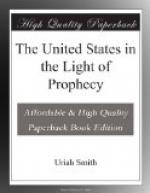This symbol has “two horns like a lamb.” To those who have studied the prophecies of Daniel and John, horns upon a beast are no unfamiliar features. The ram, Dan. 8:3, had two horns. The he goat that came against him had, at first, one notable horn between his eyes. This was broken and four came up in its place toward the four winds of heaven. From one of these came forth another horn, which waxed exceeding great. The fourth beast of Daniel 7 had ten horns. Among these, a little horn with eyes and mouth, far-seeing, crafty, and blasphemous, arose. The dragon and leopard beast of Rev. 12 and 13, denoting the same as the fourth beast of Dan. 7, in its two phases, have each the same number of horns signifying the same thing. And the symbol under consideration has two horns like a lamb. From the use of the horns on the other symbols, some facts are apparent which may guide us to an understanding of their use on this last one.
A horn is used in the Scriptures as a symbol of strength and power, as in Deut. 33:17, and glory and honor, as in Job 16:15.
A horn is sometimes used to denote a nation as a whole, as the four horns of the goat, the little horn of Dan. 8, and the ten horns of the fourth beast of Dan. 7; and sometimes some particular feature of the government, as the first horn of the goat, which denoted not the nation as a whole, but the civil power as centered in the first king, Alexander the Great.
Horns do not always denote division, as in the case of the four horns of the goat, &c.; for the two horns of the ram denote the union of Media and Persia in one government.
A horn is not used exclusively to represent civil power; for the little horn of Daniel’s fourth beast, the papacy, was a horn when it plucked up three other horns, and established itself in 538. But it was then purely an ecclesiastical power, and so remained for two hundred and seventeen years from that time, Pepin, in the year 755, making the Roman pontiff a grant of some rich provinces in Italy, which first constituted him a temporal monarch. (Goodrich’s Hist. of the Church, p. 98. Bower’s Hist. of the Popes, Vol. 2, p. 108.)
With these facts before us, we are prepared to examine into the significance of the two horns which pertain to this beast. Why does John say that he has two horns like a lamb? Why not simply two horns? It must be because these horns possess peculiarities which indicate the character of the power to which they belong. The horns of a lamb indicate, first, youthfulness, and secondly, innocence and gentleness. As a power which has but recently arisen, the United States answer to the symbol admirably in respect to age; while no other power, as has already abundantly been proved, can be found to do this. And considered as an index of power and character, it can be decided what constitutes the two horns of the government, if it can be ascertained what is the secret of its strength and power, and what reveals its apparent




